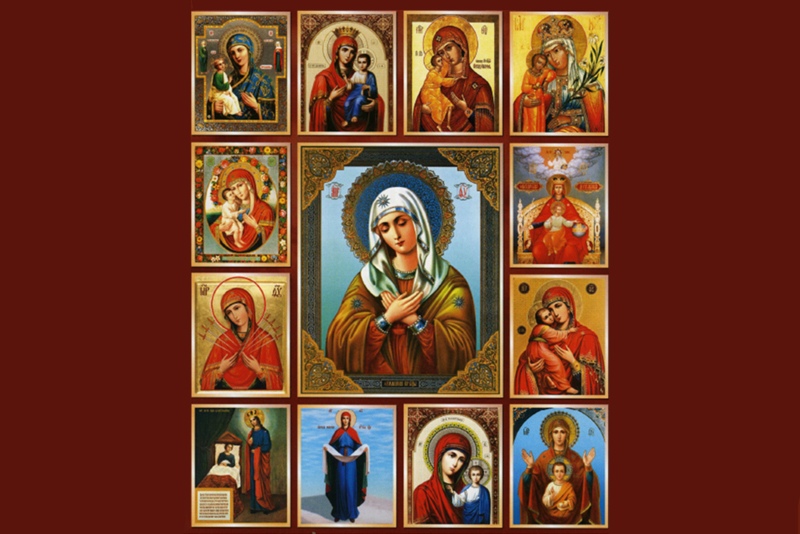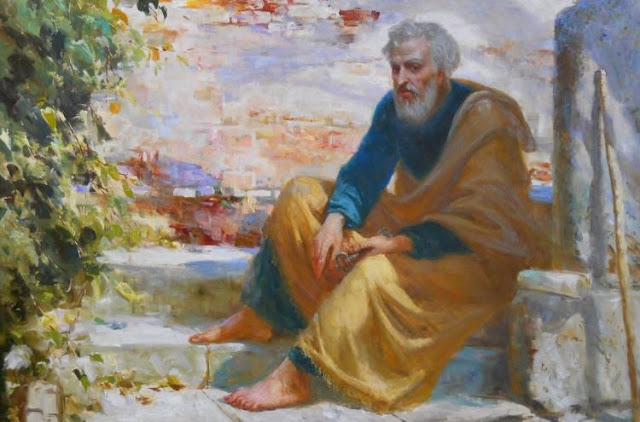
St Peter was born in the city of Capernaum. Here he owned a house, in which Jesus Christ often visited during His mission on the shores of Lake Galilee. In the beginning of the first millennium AD, Capernaum was a large and famous city. In 746, a strong earthquake happened here, which caused significant destruction in the city. Capernaum gradually fell into decay and was finally abandoned by its inhabitants several centuries later. The remains of Capernaum were discovered by Franciscan archaeologists as late as in the 19th century; and the house of St Peter was identified in the second half of the 20th century.

City of Capernaum 2000 Years Ago
The word Capernaum is translated as “the village of Nahum”. According to a popular version, the settlement was named after the prophet Nahum, but it is also possible that there once was some local resident with the same name, who built the first house on the site of the future city, thus giving it its name. One way or another, the “village of Nahum” appeared in the second century BC. At the time of Peter the Apostle , there was already a small city here, with a Roman garrison headed by a centurion and a publican (tax collector). The city stretched out in a narrow strip along Lake Galilee; the distance from the first to the last house was only 300 meters. All houses in Capernaum were built from black basalt, a material widely used in this area. They were very small and simple in architecture; apparently, building something more expensive and complex was beyond the local residents’ means. The houses were built in close proximity to one another and, as is often the case in countries with hot climates, had within their walls small courtyards with trees. Most of the inhabitants of Capernaum were engaged in fishing. Archaeologists were able to discover here an ancient pier protruding deep into the waters of Lake Galilee and used by the fishermen to tie their boats. Inside the city, the remains of a building were found with small pools for the caught fish, apparently, a local fish market.
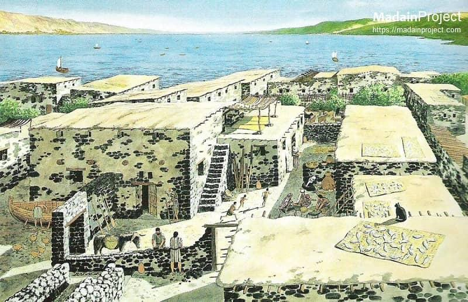
Capernaum in the Gospel
In the Gospel, Capernaum is called the city of Jesus: “And after getting into a boat he crossed the sea and came to his own town” (Mt 9: 1). The apostles, brothers Peter and Andrew lived in Capernaum. Apparently, this was the reason why Jesus chose Capernaum as His permanent refuge in Galilee. “He went down to Capernaum, a city in Galilee, and was teaching them on the sabbath” (Luke 4:31). Capernaum was where the apostles went fishing; it is also a place where Jesus performed many of His miracles, healing Peter’s mother-in-law, the centurion’s servant and the paralyzed man. Jesus did not have his own house in Capernaum and stayed with Peter. “After leaving the synagogue he entered Simon’s house. Now Simon’s mother-in-law was suffering from a high fever, and they asked him about her. Then he stood over her and rebuked the fever, and it left her. Immediately she got up and began to serve them. As the sun was setting, all those who had any who were sick with various kinds of diseases brought them to him; and he laid his hands on each of them and cured them” (Lk 4: 38-40).
Searching for Peter’s House
It was obvious to the archaeologists that being a poor Capernaum fisherman, Peter lived in one of the black basalt houses. But it was problematic to determine which one it was. To answer this question, archaeologists have carefully studied the history of Capernaum after the Gospel events.
In the first centuries AD, Capernaum became a thriving trading city. Perhaps this is what Jesus meant when he said, “And you, Capernaum, will you be exalted to heaven? No, you will be brought down to Hades” (Matt 11:23). Pilgrims flocked to the city to see the place where Jesus preached and where the apostles lived. The famous pilgrim Egeria, for example, visited Capernaum between 381 and 384 and left the following record, “In Capernaum, the house belonging to the chief of the apostles has been converted into a church. Its walls however have remained the same and still stand. …. There is also a synagogue here, where the Lord healed a sick person”. These documented words meant that the archaeologists had to look not for a private house, but for a Christian church!
The remains of an ancient octahedron-shaped church were indeed discovered during the excavations. The studies of the remains of some household ceramics found on the church site showed that until about the middle of the 1st century it was an ordinary house and people lived here. But then the house ceased to be residential, and the household dishes were replaced by large storage vessels and lamps, found in the layers of the appropriate time. Graffiti mentioning God Jesus and Christ also appeared on the plaster covering the walls. In the fourth century, the central room of the house was expanded and furnished with two entrances (from the north and south) and a more stable roof. This was the church seen by Egeria.
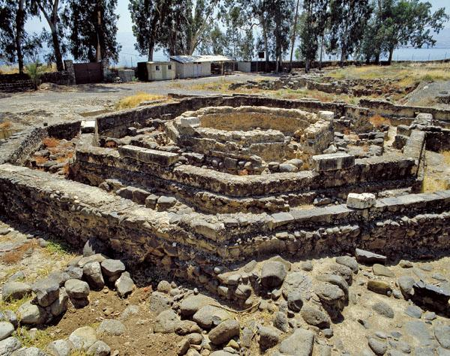
There is reason to believe that the church was arranged here with the participation of Joseph of Tiberias. In the middle of the 5th century, the church acquired its shape of an octahedron and a mosaic floor; an apse with a baptistery was added to it later.
The synagogue in which Jesus preached was also found by archaeologists. It was located not far from Peter’s house. Like the church, the synagogue was also rebuilt in the 4th century AD. Its new walls were erected using expensive imported white stone. However, they stood on the old synagogue foundations of the Gospel time, which, like all the houses in Capernaum, was built of black basalt.

The church suffered greatly during the Persian invasion in 614. The synagogue was most likely destroyed in 629, when the Byzantine emperor Heraclius came here. The city residents who survived these dramatic events decided not to restore the ashes, but to build new houses to the east of the old settlement. The earthquake of 746 completed the devastation started by the wars. The city was destroyed and after some time also abandoned by its last inhabitants.
What is Here Now?
The ruins on the site of the ancient Capernaum are now in the possession of the Franciscan order. This place is currently an open-air museum. The modern Franciscan temple, reminiscent of a flying saucer with legs, covers and protects the remains of Peter’s house excavated by archaeologists.
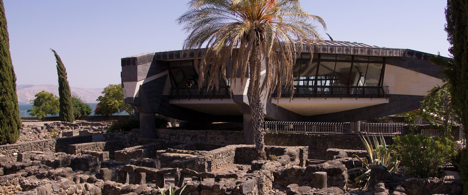
The church is open only to worshippers. Through the glass floor you can see the old walls where Peter and Jesus once lived, the ancient graffiti from the middle of the first century and the remnants of the Byzantine mosaic.

However, in the author’s opinion, these stones can hardly be ‘revived’ in the mind of a visitor with no archaeological background. Another popular pilgrimage site here is the Temple of the Twelve Apostles, which belongs to the Jerusalem Orthodox Church and is located within a hundred meters from the museum. Of course, the white church with red Easter domes has nothing to do with the architecture of the Savior’s times. Next to the temple there is a green garden overlooking the lake shore with seagulls and the fish glaring in the clear water. Perhaps similar gardens surrounded the ancient Capernaum. In the garden’s shade there are some stone tables and seats, from which pilgrims can watch the multi-colored peacocks walking by. The creator and gate-keeper of this garden is Father Irinarchos, a Greek monk and a kind of a local landmark. He leads a quiet, simple life, working in the garden and talking with pilgrims. Perhaps, this place serves best to imagine how people lived in Capernaum 2000 years ago.
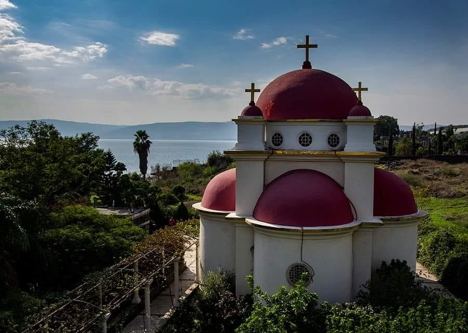
Once a week, a liturgy in Slavonic is celebrated in the church for the Russian-speaking Orthodox Christians living in the area.
Translated by The Catalogue of Good Deeds
Source: https://foma.ru/dom-apostola-petra-gde-byval-sam-iisus-kak-arheologi-umudrilis-obnaruzhit-ego-spustja-celyh-dvadcat-vekov.html


